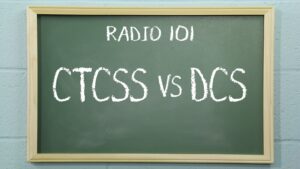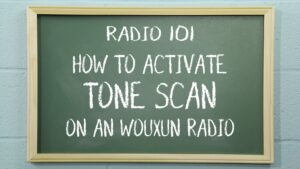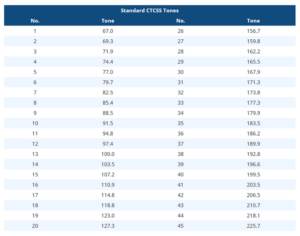CTCSS is an acronym for Continuous Tone Coded Squelch System. It is a set of sub-audible tones that act as filters to eliminate interference from unwanted transmissions originated by other individuals or groups who are operating on the same channel or frequency. CTCSS tones are also commonly known as Interference Eliminator codes, PL or Private Line codes, QT codes, channel guard, or subchannels.
Some consumer and business radios that support CTCSS tones may assign a number to each tone within the radio menu for selection and programming options. Other radios simply list the tones themselves and allow you to choose them directly.
It is important to understand that there is no universal or industry-wide standard for CTCSS tones or their number assignments in a radio. Also, some radios may only support certain tones and may not support others.
This article covers CTCSS tones only. For DCS codes, please refer to the Chart of Standard DCS codes.
Listed below is a chart of CTCSS tones often used for two way radios, along with common tone number assignments for radios that use them. Again, these tone number assignments are a general guide only and may vary between makes and models of two way radios. Consult the user manual for your radio for the specific tones supported.
Common CTCSS Tones
| Common CTCSS Tones |
| No. | Tone | No. | Tone |
| 1 | 67.0 | 20 | 131.8 |
| 2 | 71.9 | 21 | 136.5 |
| 3 | 74.4 | 22 | 141.3 |
| 4 | 77.0 | 23 | 146.2 |
| 5 | 79.7 | 24 | 151.4 |
| 6 | 82.5 | 25 | 156.7 |
| 7 | 85.4 | 26 | 162.2 |
| 8 | 88.5 | 27 | 167.9 |
| 9 | 91.5 | 28 | 173.8 |
| 10 | 94.8 | 29 | 179.9 |
| 11 | 97.4 | 30 | 186.2 |
| 12 | 100.0 | 31 | 192.8 |
| 13 | 103.5 | 32 | 203.5 |
| 14 | 107.2 | 33 | 210.7 |
| 15 | 110.9 | 34 | 218.1 |
| 16 | 114.8 | 35 | 225.7 |
| 17 | 118.8 | 36 | 233.6 |
| 18 | 123.0 | 37 | 241.8 |
| 19 | 127.3 | 38 | 250.3 |
Some higher end radios support an expanded list of CTCSS tones. Wouxun in particular Includes a set of 50 tones, and a few models support both standard and non-standard tones for even greater flexibility.
The List below is a chart of CTCSS tones that Wouxun typically supports in its line of radios, along with their number assignments.
Wouxun CTCSS Tones
| Wouxun Standard CTCSS Tones |
| No. | Tone | No. | Tone |
| 1 | 67.0 | 26 | 156.7 |
| 2 | 69.3 | 27 | 159.8 |
| 3 | 71.9 | 28 | 162.2 |
| 4 | 74.4 | 29 | 165.5 |
| 5 | 77.0 | 30 | 167.9 |
| 6 | 79.7 | 31 | 171.3 |
| 7 | 82.5 | 32 | 173.8 |
| 8 | 85.4 | 33 | 177.3 |
| 9 | 88.5 | 34 | 179.9 |
| 10 | 91.5 | 35 | 183.5 |
| 11 | 94.8 | 36 | 186.2 |
| 12 | 97.4 | 37 | 189.9 |
| 13 | 100.0 | 38 | 192.8 |
| 14 | 103.5 | 39 | 196.6 |
| 15 | 107.2 | 40 | 199.5 |
| 16 | 110.9 | 41 | 203.5 |
| 17 | 114.8 | 42 | 206.5 |
| 18 | 118.8 | 43 | 210.7 |
| 19 | 123.0 | 44 | 218.1 |
| 20 | 127.3 | 45 | 225.7 |
| 21 | 131.8 | 46 | 229.1 |
| 22 | 136.5 | 47 | 233.6 |
| 23 | 141.3 | 48 | 241.8 |
| 24 | 146.2 | 49 | 250.3 |
| 25 | 151.4 | 50 | 254.1 |









